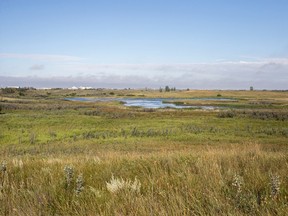Now composed of rare native grasslands, wetlands, and patches of aspen trees, the Small Swale is an incredible mix of ecosystems and habitat.

Reviews and recommendations are unbiased and products are independently selected. Postmedia may earn an affiliate commission from purchases made through links on this page.
Article content
Once a hidden gem, the Small Swale area in Saskatoon is making its way to the main stage.
Located near the east end of Chief Mistawasis Bridge, on either side of McOrmond Drive, the land is mostly owned by the City of Saskatoon and is now facing various development pressures. The area has been living in the preservation shadows of the Northeast Swale for too long.
Advertisement 2
Article content
Article content
Although winter is not done with us yet, it’s a good time to call attention to the orchids, rare flowers and birds galore that call the Small Swale home and will soon be on display once again. As we become more aware of the threats that nature and our planet are facing, we look to these important natural spaces to conserve biodiversity and integrate climate change adaptation measures into our city.
Like the Northeast Swale, the Small Swale is an ancient river channel, formed as the glaciers retreated, leaving behind a glacial till plain over top of boulders and rocky material. The South Saskatchewan River eventually carved its way through the plains, at one-time flowing through the Small Swale. Then it dramatically changed course and left the swale stranded and distinctive. Now composed of rare native grasslands, carbon-sequestering permanent and semi-permanent wetlands, and patches of aspen trees, the Small Swale is an incredible mix of ecosystems and habitat.

Walking through this landscape, one hears sounds of the Prairie, from grasshoppers, crickets and birds to wind in the grass. Western meadowlarks sing and clay-coloured sparrows buzz from the wolf willows. Swainson’s hawks soar above, screeching in the hot summer sun.
Article content
Advertisement 3
Article content
This habitat hosts many rare bird species during breeding season and through spring and fall migration, including the loggerhead shrike, bobolink, barn swallow, short-eared owl, common nighthawk, rusty blackbird and more. White-tailed and mule deer, along with other small mammals, also call the Small Swale home and use it as a corridor for movement.
There are many grassland plant species here, some that are increasingly rare in the province. On the slopes and tops of the rocky ridges, you’ll find the rare crowfoot violet and plains rough fescue; lower on the ridge blooms our provincial flower, the Western red lily.
Not only does this special place have important grassland species, but it also has a plethora of unique wetland species, making it a double feature of ecological diversity. At the edges of the wetlands, you’ll find northern green orchids and saline shooting stars, culturally significant sweetgrass, and the rare marsh felwort. Northern leopard frogs jump at your feet while sedge and marsh wrens trill and buzz at your presence. Further into the wetland, ducks, soras, and red-winged and yellow-headed blackbirds stake out their territories. Tall cattails hide their presence but, from above the rocky Prairie ridges, you can get a literal bird’s eye view of who is hiding below in the landscape.
Advertisement 4
Article content
This birding paradise does not disappoint.

As the City of Saskatoon continues to sprawl outward, there are plenty of challenges facing the Small Swale. Many are due to a lack of ecosystem management, including invasive species and pollutants from the snow-and-street-sweeping dump south of McOrmond Drive.
The planned UH3 neighbourhood, including commercial development to the east and industrial to the northwest, will also put pressures on the Small Swale. The proposed Saskatoon Freeway will run a 10-lane interchange right on top of the Small Swale, connecting to Central Avenue.
This exceptional place needs the city’s residents to speak up for it.
But it is not all doom and gloom. The Small Swale has proven its resilience, surviving human-caused changes over the decades. With strong leadership and citizen support it has the potential to survive for many more. The city is currently creating a Natural Area Management Plan for the Small Swale, which will hopefully open this beautiful landscape up to the public as another fantastic natural space — an outdoor classroom for students and residents alike in and around Saskatoon.
Advertisement 5
Article content
The Small Swale is located on the west side of Range Road 3050, just off McOrmond Drive (north of the Saskatoon Wildlife Federation). Access to the site is via a right-of-way road. Park just off Range Road 3050.
The Swale Watchers continue to advocate for this ecologically significant area. If you are interested in learning more, follow us on Facebook and Instagram or join our mailing list by emailing swalewatchers@gmail.com.
Meghan Mickelson is a member of the Swale Watchers, Wild About Saskatoon and the Saskatoon Nature Society.
Recommended from Editorial
With some online platforms blocking access to the journalism upon which you depend, our website is your destination for up-to-the-minute news, so make sure to bookmark thestarphoenix.com and sign up for our newsletters here so we can keep you informed. Click here to subscribe.
Article content





